
Topics
Guests
- Dahr Jamailindependent journalist and Truthout staff reporter. Author of The End of Ice: Bearing Witness and Finding Meaning in the Path of Climate Disruption.
A new report finds at least a third of the Himalayan ice cap will melt by the end of the century due to climate change, even if the world’s most ambitious environmental reforms are implemented. The report, released by the Hindu Kush Himalaya Assessment earlier this month, is the culmination of half a decade’s work by over 200 scientists, with an additional 125 experts peer reviewing their work. It warns rising temperatures in the Himalayas could lead to mass population displacement, as well as catastrophic food and water insecurity. The glaciers are a vital water source for the 250 million people who live in the Hindu Kush Himalaya range, which spans from Afghanistan to Burma. More than 1.5 billion people depend on the rivers that flow from the Himalayan peaks. We speak with Dahr Jamail, independent journalist and Truthout staff reporter. He is the author of the new book “The End of Ice: Bearing Witness and Finding Meaning in the Path of Climate Disruption.”
Transcript
AMY GOODMAN: This is Democracy Now!, democracynow.org, The War and Peace Report. I’m Amy Goodman, with Juan González.
JUAN GONZÁLEZ: Well, a shocking new report finds at least a third of the Himalayan ice cap will melt by the end of the century due to climate change, even if the world’s most ambitious environmental reforms are implemented. The report, released by the Hindu Kush Himalaya Assessment earlier this month, is the culmination of half a decade’s work by over 200 scientists, with an additional 125 experts peer reviewing their work. It warns rising temperatures in the Himalayas could lead to mass population displacement, as well as catastrophic food and water insecurity. The glaciers are a vital source for the 250 million people who live in the Hindu Kush Himalayan range, which spans from Afghanistan to Burma. The region is home to the most ice in the world, after Antarctica and the Arctic. More than 1.5 billion people depend on the rivers that flow from the Himalayan peaks.
AMY GOODMAN: Meanwhile, an alarming new report has found more than 40 percent of insect species around the world may become extinct in the next few decades. Although the study’s authors point to industrial agriculture as the main culprit, they also lay blame on climate change, citing warming temperatures that have led to sudden decreases in insect population in places like Puerto Rico, where nearly 100 percent of ground rainforest bugs have disappeared in just 35 years.
This devastating news comes as 2018 was found to be the fourth-warmest year on record. The past five years have been the five warmest since reliable measurements began more than a century and a half ago.
We go now to Seattle to talk to journalist Dahr Jamail, author of four books, including his most recent, The End of Ice: Bearing Witness and Finding Meaning in the Path of Climate Disruption. Dahr was awarded the Martha Gellhorn Prize for Investigative Reporting for his reporting from the Iraq War. Last year, he won an Izzy Award for his ongoing coverage of human-caused climate change.
Dahr, welcome back to Democracy Now! Thank you so much for driving two hours in a snowstorm to get to Seattle to be with us today. Can you talk about these latest reports of, once again, precedent-setting, climate change-related developments in the world?
DAHR JAMAIL: They’re more indications of how far along we already are, regarding human-caused climate disruption. Excuse me. They essentially underscore that we are on a warming trend now that’s unprecedented, unlike anything that we’ve ever seen since humans have been on the planet. And it’s very disconcerting. And we can really look across the globe and see these giant alarm bells, like the melting of the glaciers in the Himalaya, the collapse of insect populations, which that same report said, at the current trajectory, assuming we don’t speed up or these trends don’t speed up, which they may well do that, we could lose all insects by 2100.
If we look at what’s happening to glaciers in the United States, just in the contiguous 48 states, in Glacier National Park, a lead expert there told me that we could probably not have any glaciers left whatsoever in Glacier National Park by just 2030. That’s just 11 years from now. He went on to say, along with several other experts, which is that there could be no glaciers left anywhere in the contiguous 48 at all by 2100. And then, think about the implications of this, not just for, of course, the natural implications then on ecosystems, which are massive, but like the Hindu Kush, so many people depend on these glaciers for drinking water and irrigation. So, these alarm bells are ringing very, very loudly all around us. And that’s really just a few of the overt ones right now.
JUAN GONZÁLEZ: Well, Dahr, in your new book, you talk about—at one point, you say, “As a species, we now hang over the abyss of a geoengineered future we have created for ourselves. At our insistence, our voracious appetite is consuming nature itself. We have refused to heed the warnings Earth has been sending, and there is no rescue team on its way.” That’s a pretty dim sense of what lies ahead. Could you talk about the response of governments and the human race to what’s going on?
DAHR JAMAIL: Well, it is why I think we’re in such a grim situation. Because I went to many of the hotspots, the front lines of climate disruption around the world, from Denali up in Alaska to the Amazon rainforest to the Great Barrier Reef to South Florida for sea level rise and many other places. And in each place, really, what we’ve seen is catastrophic declines of—whether it’s biodiversity in the Amazon to the loss of ice up in the Alaskan Range to how fast now sea level rise is starting to accelerate, and that all of these crises that are—it’s a myriad of them happening simultaneously, held against the backdrop of—you know, the majority of the population, even in this country, with a fossil fuel industry-driven denial mechanism, even here, we have the majority of the people understand that climate disruption is real and that something needs to be done about it. And yet, like other countries, as well, we have a government that is not only not doing anything about it, but is instead stomping on the gas. And so, another reason things are so grim.
And really, when you connect all the dots and look at what’s happening across the planet, against the backdrop of this really pathetic government response on any—in any way that’s coming close to what has to happen to actually mitigate this crisis. I mean, we all know it’s—the cat’s out of the bag on the fact we’re not going to stop it. The only question is: Are we going to be able to mitigate it?
And, you know, the best science now shows that even if we stopped all fossil fuel emissions today, and everything—you know, all governments started to react accordingly, most likely we have a minimum of 3 degrees C warming that’s already baked into the system. And so, hold that up against how governments are reacting. I mean, we should be having global, coordinated response on a dramatically emergency level. And instead, it’s business as usual in at least the leading countries—you know, the U.S., China, India and Russia, the leading greenhouse gas-emitting countries on the planet. And instead of going into an emergency response and mandated CO2 emission cuts and getting off fossil fuels as rapidly as possible, they’re just stomping on the gas and pretending like we can keep kicking this can down the road.
And the reality is that it’s not a future crisis. I want to underscore the point that this is happening now. As we speak, the Great Barrier Reef is in terminal stage. As we speak, we already have set in motion things that are going to erase glaciers from the contiguous 48 states, probably well before 2100. As we speak, the Amazon is under grave, grave threat and already has warming cycles happening there that are unprecedented in droughts. So, we have to really, I think, start thinking about that in this way, that the future that we’ve all thought was going to be so much further down the line, or 2100, and catastrophic, it’s already happening now.
AMY GOODMAN: We’re going to break and then come back to this discussion and find out why you left war reporting, what we interviewed you so much about over the years, living in the Middle East for the years that you did, to cover the issue of climate change. Dahr Jamail’s new book is called The End of Ice: Bearing Witness and Finding Meaning in the Path of Climate Disruption. It’s just out. Stay with us.
[break]
AMY GOODMAN: “Plastic Jesus,” performed by Tia Blake. This is Democracy Now! I’m Amy Goodman, with Juan González. Our guest is Dahr Jamail, independent journalist, author of the new book The End of Ice: Bearing Witness and Finding Meaning in the Path of Climate Disruption.
So, Dahr, take us on that journey of your life, from war reporting to climate change, from the highest peak, Denali in Alaska, to the Coral Sea.
DAHR JAMAIL: Well, it really did start when I first saw Denali, and that drove me to move up to Alaska. I just really fell in love with mountaineering and wanted to spend as much of my life as I could up in those amazing places on the planet. But immediately, I was confronted with, back—this is in 1996—the dramatic loss of glaciers, the retreat that was already happening, the crazy weather swings that were already occurring across Alaska at that time. And so, it was very, very clear to anyone up there spending a lot of time in the mountains what was already upon us then.
And then, of course, the Iraq War, being called to go follow the need to go provide reporting there about how that war was impacting the Iraqi people. It’s interesting in that, you know, covering that for as long as I did, and the really dramatic, you know, how—again, how obvious it was early on in that war what was happening, how bad it was. I mean, it was impossible to land on the ground there and not know that already so many Iraqis were being killed, so many Iraqis were being tortured.
But an interesting parallel, that I want to bring this up to tie this in to current reporting on climate disruption, is that I can remember acutely, at that time, reporting on torture, reporting on the home raids, reporting on the atrocities being carried out by the U.S. military in Iraq, reporting on illegal weapons and things like this, much of it on Democracy Now!, and yet, you know, the mainstream media ignored it. And, of course, most people in this country, it took years before it really seeped in how catastrophic that invasion and occupation was for the Iraqi people, and, of course, for the U.S. military.
And so, coming out of that war, going into the BP oil spill—I was living in Texas at the time and covered that. And, you know, another interesting theme, very, very obvious in all of these stories, is fossil fuels. You know, we know the root cause of climate disruption at this point is the burning of fossil fuels. And then, of course, Iraq was—it’s a no-brainer, that was a war for oil, clear and simple from day one. And then, of course, the BP oil spill, the consequences of living in a fossil fuel-based economy. And then, now, again, back to climate change, where these impacts are upon us.
And, you know, the parallel I want to bring current now, from sharing what I did about Iraq, is that, you know, I’ve been out on the front lines of where climate change is the most obvious. And I’m far from the only reporter on this beat, and certainly there’s plenty of others who have been on it longer than I. But that said, you know, what I want to impart is that what’s happening right now, as we speak, we are in this. We are in the era of loss. We are in a situation where the planet is already irrevocably changed.
And so, the Great Barrier Reef being in terminal stage. I was there in 2017 for the first week of the coral bleaching event that struck the reef that year, which went on to kill 30 percent of the area that bleached. The next year, another coral bleaching event, 20 percent was lost that bleached. So, there you have 50 percent lost in just two years. This is why scientists there are referring to the reef being in a terminal stage, and probably won’t last another 10 years. This is the single biggest coral ecosystem on the planet.
And if we look at what’s already baked into the system with sea level rise, one of the scientists I interviewed at University of Miami, Dr. Harold Wanless, said we could see not just the IPCC worst-case prediction by 2100, but we could see—which is around the lines of somewhere between six feet and eight feet—we could see as much as 20 to even 30 feet even by then. And if you look at the collapsing ice sheets in the Antarctic—I mean, just a few weeks ago, we had another report, that the lead author of, Dr. Eric Rignot of UC Irvine, one of the leading glacial scientists studying what’s happening in the Antarctica—that report showed a sixfold increase in melting across that continent just since the 1970s.
So, things are happening. They’re accelerating. And it’s very, very clear where we are in this crisis. And so, it’s really amazing to me I’m having that same experience as I did in Iraq of being on the streets of Baghdad or being in Fallujah, writing these reports, telling people what’s happening, and then waiting for kind of the rest of the country to keep up and wake up and really see what’s happening, that we’re in a situation where we’re talking about 2100, and reality is, you know, we’re talking about right now. It’s happening right now.
JUAN GONZÁLEZ: Dahr, could you also talk about the thawing of the permafrost and the potential—the impact and significance of this, as well?
DAHR JAMAIL: That’s right. So, I went up to Utqiagvik, a town formerly known as Barrow, in northern Alaska. It’s the northernmost point in that state. And I went up there specifically to see the situation of the permafrost and deepen my investigations into the methane up there. So, the permafrost, you know, the terrestrial permafrost, is melting—I’m sorry, it’s thawing dramatically. And it’s warming up even tens of feet below the surface. And what’s disconcerting about that is this holds a vast store of organic material, so as it thaws, it’s releasing both CO2 and then a smaller amount of methane up into the atmosphere. And that’s already happening. That thawing is occurring. And the scientist I spoke with said he expects all of the permafrost across northern Alaska to be well above freezing, well in advance of 2100.
And then, the permafrost, as it goes underneath the shallow seas of the Arctic, contained within it is methane hydrates. And that is starting to thaw out. So, as the ice cap recedes, the summer sea ice, as the oceans warm, both from warmer water coming up from the Atlantic, as well as now more solar radiation coming in from above, and the atmosphere warming, those hydrates are starting to be released. And so, one of the scientists I interviewed for my book, Dr. Ira Leifer, spoke of a paper that he had published actually several years ago, where the normal background rate for methane seeps from a seabed in that area is approximately 3,000 methane seeps over a thousand-square-kilometer area. He had—using satellites to measure the methane, he had found another thousand-square-kilometer area where there were already 60 million methane seeps that were coming up from the base of the Arctic seabed.
AMY GOODMAN: Dahr, President Trump, mocking one of the candidates running for president, Senator Klobuchar, said—he said, “Amy Klobuchar announced that she is running for President, talking proudly of fighting global warming while standing in a virtual blizzard of snow, ice and freezing temperatures. Bad timing,” he said. “By the end of her speech she looked like a Snowman(woman)!” he said. But he continually repeats this issue, the issue of, “Look, the country is in a polar vortex. You call this global warming?” Please explain the process by which the Earth getting warmer can mean freezing weather, as well as, you know, desertification.
DAHR JAMAIL: This is why I call it climate disruption and not climate change. You know, it’s because when you inject as much CO2 into the atmosphere as we have, it doesn’t just change the climate, it completely disrupts it. And that’s exactly what the polar vortex is a sign of. It’s the opposite of what this individual in the White House—you know, I’m hesitant to really call him any kind of a name. It’s just still stunning to me that there’s someone like this there. But let’s not conflate weather with climate; these are two separate things. So, that’s one.
And then, the other being that the polar vortex is actually a sign of the opposite of what Mr. Trump is saying, that it somehow negates the reality of climate disruption. So, when you have destabilized temperatures, when you have temperatures not in their normal range, the jet stream, rather than being steady, it becomes disrupted, and we have these huge flows sometimes that come down into the lower 48, and that’s—and letting all that Arctic air down here. Conversely, you look up in the Arctic, and temperatures up there are nowhere near as cold as they normally are. And that’s a big part of why we have the problem with the thawing permafrost and the methane crisis that I just spoke of.
So, and on that note, one thing that I forgot to add earlier is, methane is, over a 10-year timescale, an 85—it’s 85 times more potent as a greenhouse gas than CO2. So, the consequences of that methane starting to be released and the possibility of a dramatic, sudden burst of it coming out all at once could literally happen at any moment, and if there’s enough methane there, that we could that the CO2 equivalent released of—on par of half, again, as much CO2 as we’ve already emitted into the atmosphere since the Industrial Revolution began.
JUAN GONZÁLEZ: And, Dahr, what hope do you see in the new young leaders that have come forward and the activists in recent years—I’m thinking of Alexandria Ocasio-Cortez and her proposal for the Green New Deal—for this to become more than just a gadfly or opposition movement, but actually effect real change in how this nation and other nations begin to deal with climate disruption?
DAHR JAMAIL: I think these are valiant efforts and very, very heartening. I look at it now through a perspective that I learned from an indigenous man that I met and interviewed for my book and brought him into the closing chapter, Stan Rushworth, who—of Cherokee descent, who—he’s who reminded me that Western colonial mindset is that we each have rights, whereas indigenous wisdom teaches that we’re all born into this world with certain obligations. And talking about the climate crisis through that lens, we have a moral obligation to future generations and to serve and take care of the planet.
And so, when we see people like Cortez bringing out the Green New Deal, and the Sunrise Movement that’s behind that, and other movements like this, it’s—I see these people really acting from that moral responsibility of: What can we do to take care of future generations? What do we need to do to try to save a few more species? What else can we do individually to find different parts of the planet and start to take care of it, especially at a time when governments are not doing what they’re supposed to be doing in how they ought to be responding to this? So, I look out and I see movements like this as really acts of deep integrity and great courage, at a time when everything seems to be stacked behind us.
Because I think what we need to remember—it’s so easy to look at the big picture and get completely disheartened when we do that. And I think what we need to remember is: What is my own personal moral obligation? And when I wake up each day thinking about what I might do from that perspective, instead of having hope or coming at it from a more activist perspective, when I really come at it with a deep sense of moral obligation, it really doesn’t matter what the results are. What matters is: Am I doing the right thing? And am I doing all I can right now at this time of crisis?
AMY GOODMAN: Dahr, can you describe your journey to the Amazon, to the lungs of the planet?
DAHR JAMAIL: I was privileged to get to go there and go to Camp 41. It’s the most famous of the study camps of Dr. Thomas Lovejoy, a great scientist, who is also sometimes referred to as the “Godfather of Biodiversity.” He has been studying down there since 1965. And getting to go into this camp was an extraordinary experience. It’s a camp that—that camp alone has been the producer of over 700 peer-reviewed published scientific studies about different aspects, from trees to insects to birds to animals to soils, you name it. And getting to go there with him was profound, because he really—I really understood and felt it in my body, when you go to a place so rich in diversity as the Amazon, how literally the jungle itself started to kind of take me in. I mean, anyone that has been there, I think, would relate to this, where literally everything from how you feel to how you start looking at things to even your dreams at night start to change, as you really start to kind of become one with the jungle there.
And Dr. Lovejoy, though, however, was troubled, because if you look at what’s happening to the Amazon with the increasing temperatures, the increasing amount of droughts, wildfires, and then, of course, human encroachment—one of the biggest problems there is the Amazon being hacked away and replaced with pastures so that cattle can be raised for beef. And all of these things were converging to cause a problem, in that the Amazon, where under normal circumstances it becomes a carbon sink—it draws CO2 out of the atmosphere into the trees, into the soil—and because of the drought and the warming temperatures, there’s actually already been longer periods, from weeks even to, at times, a couple of months, where it’s actually become a net carbon source in releasing CO2 back into the atmosphere. And as temperatures warm and all of these other climate disruption impacts intensify across the Amazon, unfortunately, it appears as though we’re locked in to start seeing that happen a lot more. And then, as a consequence, the incredibly rich biodiversity that is there is under threat.
And the final note on that, that he shared, that I think was really profound and important for people to know, so many of our pharmaceuticals come from the Amazon. And if we’re going to be destroying parts of it and losing species that we don’t even know exist yet, we might be taking out things that we’re going to need in order to develop pharmaceuticals from future diseases that haven’t even happened yet. So, from just a purely human self-interest standpoint, it is an imperative situation to understand what’s happening to the Amazon and the need to protect it.
AMY GOODMAN: Dahr Jamail, we want to thank you so much for being with us. His new book, The End of Ice: Bearing Witness and Finding Meaning in the Path of Climate Disruption.
That does it for our broadcast. Democracy Now! is currently accepting applications for a full-time, 1-year paid news production fellowship. Details at democracynow.org.

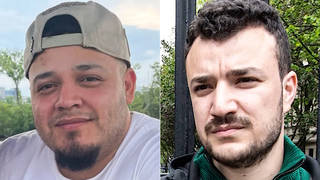

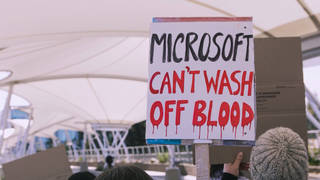
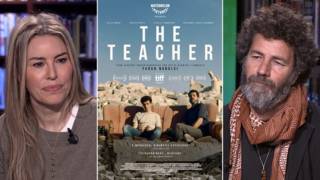





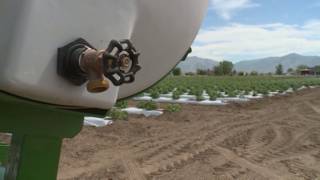
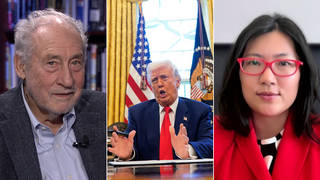
Media Options